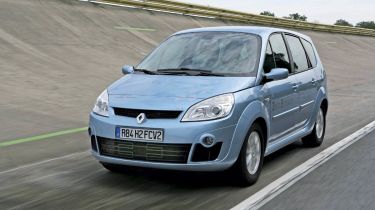Renault Scenic ZEV H2
Hydrogen power has arrived in the MPV sector – but just how practical is it?

AS a piece of technology the Scenic ZEV H2 is little short of amazing. It is a ‘normal’ people carrier in every sense – apart from emitting only water. If a support infrastructure can be set up it could contribute to a seismic shift in motoring. However, questions remain over the energy and carbon intensity of actually building cars such as this, so there’s still some way to go before personal transport becomes truly eco-friendly.
THIS might look like a standard Renault Scenic, but underneath that unassuming pale blue bodywork lies a glimpse ofthe future of motoring.
Promising to be the most environmentally friendly model the French firm has ever built, the ZEV H2 isn’t simply an exercise in squeezing more mileage out of every last drop of fuel; it’s a fully fledged, production-ready zero-emissions fuel cell car.
When strict EU CO2 regulations arrive in 2012, makers will be forced to maintain an average carbon rating across their range of 120g/km. This means a road-going zero-emissions production model will be a major coup.
And that is where this special Scenic comes in. Developed with Nissan, it’s powered by a fuel cell situated underneath the cabin, as well as an electric motor beneath the bonnet. The Scenic ZEV H2 emits nothing but water from the tailpipe.
The technology itself is not exactly new, and Renault doesn’t hide that fact. Based on a design first proposed when fuel cell research was in its infancy, the car uses gas and a special platinum membrane to produce electricity.
What has progressed, though, is the viability of electric vehicles such as this. It’s due to better battery technology (smaller units with longer lives) and environmental awareness, rising fuel costs and governments more willing to set up the infrastructure required to maintain the cars.
So, this vehicle will begin production in Israel in 2011. By then, 150 hydrogen stations are due to be installed in the Middle Eastern country, as well as 250,000 electric charging points. Substantial tax breaks (up to 60 per cent of the purchase price) will entice people to buy the models initially.
And if the scheme works, European governments could be persuaded to set up a similar electric car infrastructure, allowing the hydrogen revolution to begin. But is that good news for drivers?
Well, yes, actually. Granted, an MPV will never be hugely rewarding to drive, but where the Scenic ZEV H2 amazes is just how ‘normal’ it is. Everything works exactly as it would in a car with an internal-combustion engine. The only tangible difference is the eerie silence at idle and when pulling away after slipping the shifter into ‘D’.
Noise in the cabin comes only from the tyres and wind, but in every other sense the Scenic drives like a very smooth, relatively powerful automatic. It feels deceptively strong because all of the electric engine’s torque comes instantly, so throttle response is very sharp. The ride and handling are good, too: composed, well damped and very similar to the regular car’s.
So how exactly does the Scenic ZEV H2 work? The fuel cell combines hydrogen (from the boot tank) and oxygen to make electricity. This powers the motor, which drives the wheels, as opposed to a normal electric vehicle which gets energy from being ‘recharged’.
The power rating of the ZEV H2’s electric motor is 90KW – which translates to around 120bhp – and there’s also a supplementary 25KW battery. This kicks in at start-up and during aggressive acceleration, and can be recharged by regenerative braking. An LCD screen displays where power is coming from in real time, and a full tank of hydrogen is claimed to last for about 220 miles.
Renault targeted the performance of a 1.6-litre petrol engine, and that feels about right – although the car’s extra weight is apparent in corners. The change to electric power amounts to a 300kg increase, taking the kerbweight to 1,850kg.
The fuel cell Scenic is striking because its packaging is virtually uncompromised. Its ride height has been raised by 60mm so the fuel cell stack can be housed under the cabin floor, while the boot base has been lifted by 150mm to fit the hydrogen tank in, but that’s it. There’s no word yet on when the car will arrive in the UK, but it’s sure to be a huge success when it does.







